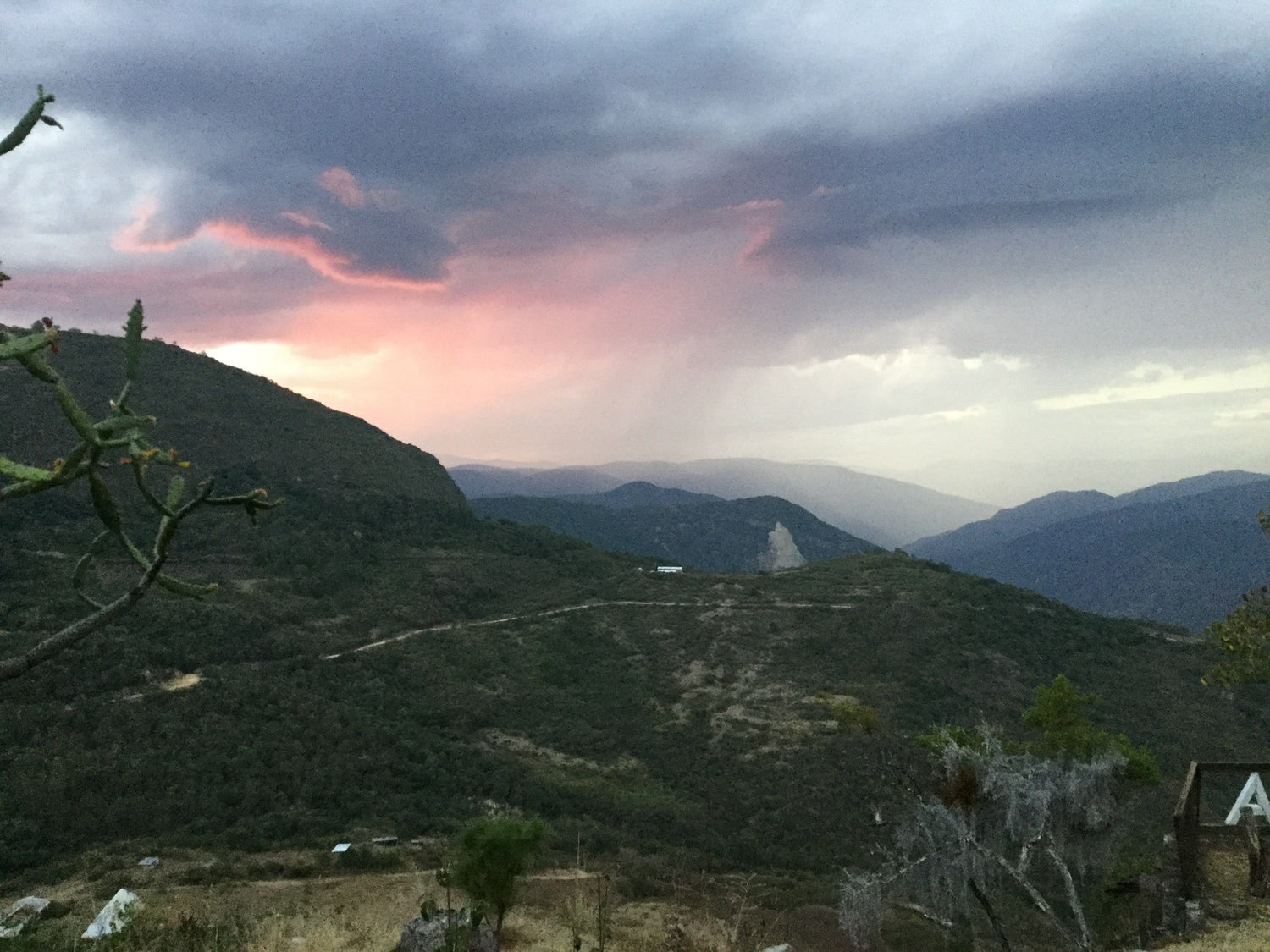Day 4: San Martha Latuvi.
As usual we get up at 6:45 and go to breakfast at 8 o'clock. The restaurant is a few meters from our cabin, it's convenient because we are always in a hurry. How ironic when we are in such a peaceful place. I wonder if people are afraid of us getting bored. I would have liked to take the time to draw, knit, read, write or just admire all the beauty around us, but no, no time for meditation or contemplation. I have the impression that we went on a tour: Visit France in one week. A day in Paris: 5 minutes to the Eiffel Tower, 5 minutes to the Arc de Triomphe, 10 minutes to a riverboat. Eat a sandwich when admiring tha Seine river. Two days on the bus. Marseille quick visit, etc ...
At 9 am we leave for San Martha Latuvi with Alfredo. As usual the trail goes up and down and it is still as beautiful with all these bromelias that Alfredo urges me to photograph, how many photos of bromelias do I have ... but today the hike is longer, about 14 km and we finish our hike in full sun with a guide who cannot finish to explain to us the virtues of a plant that we already know. Well, I'm impatient and it shows but it does not disturb our guide who continues as if he did not notice it. I ended up letting him speak alone by taking refuge in the shade of a small tree. Latuvi is a pretty village perched on top of a ridge. Once again we would have liked to relax while admiring the sight from our cabin but a craftswoman of Poulque and Tepache was waiting for us to explain the fabrication and to taste them. This craftswoman has her home all the way down the mountain, Avenida de la Cara del Leon, Avenue of the Lion's Face ... funny name for a small dirt road where there are only a few farms. It was an ultra-fast visit with a climb up the same path then we climbed the watchtower to admire the landscape and take pictures. I had to do some washing because once again I splashed the front of my white shirt with the tomato sauce that accompanied the chicken. The chickens here are very muscular, the meat is often tough and the knives are not very sharp so when I try to cut my meat, the sauce flies over me. After two washes, the stains were still very visible. I put my shirt in the sun and 30 minutes later, the stains had disappeared completely, bleached by the sun.
Latuvi is about 2000 meters above sea level, it is less cold, fortunately because the wood burning in the chimney acted like fireworks and projected sparks not far from our bed. As I have a good imagination, I see the bed on fire with us in it ... but for once, the chimney does not smoke.
Tomorrow will be our last hike and the longest to Latachao (no, it's not in China even with such a name) and San Miguel Amatlán.
Day 5: Lachatao and San Miguel Amatlán.
We left with Juan, a young man in his thirties and our picnic around 9:15. He will do half the road with us and another guide will take over. The Latuvi guides are volunteers, and it's a volunteer work because the municipality asks the population to do it, usually a few days a week for a year, sometimes two. The money from ecotourism is distributed to schools, the health center, the maintenance of roads, etc. then, everyone benefits from it. The entire population of the 8 villages of Pueblos Mancomunados must do community work to improve the appearance and the access to the village. So, instead of giving huge sums of money only to big companies that would build roads, etc. the money stays in the villages. The Latuvi guides will receive an amount of money at the end of December instead of being paid at the end of each hike, which our guide has failed to specify. He received the same tip as the others from us and it is Ernesto, our second guide who will explain the situation of the Latuvi guides. The people of these villages are happy, they say it to us, they have little money but they are healthy, they have a good quality of life and for nothing in the world they would not want to live anywhere else. They like when we tell them that we do not like living in the city and we live in the woods. Communication is very easy because we have many things in common with them. It is easy to see that these simple people are educated and aware of the world's ecological problems and the importance of conserving natural resources. They know this is everyone's responsibility. Hope this becomes contagious and that every little village that surrounds them does the same and little by little it will be the turn of cities, etc. Our Planet may have a chance to survive.
The path descends to the river, always more or less steep but we are getting used to. Once the river is crossed, this time on two broad planks, thick and solid, the landscape and the vegetation begin to change. The tall pines are rarer and the trees more abundant, including three species of oak which do not resemble ours. 8 km later, we say goodbye to Juan and meet Ernesto, a true guide who has received training. Ernesto is different from other guides, he has a lighter skin, a pretty little mustache slightly grey and he looks like a teacher who gives us a lesson in science of nature. He takes good care of us and gives us a stick to help us with the obstacles and to prevent accidents. The vegetation is now very different, there are succulents, lots of bromelias, cactuses. We are surrounded by high cliffs and we are still following the river. Ernesto looks at the sky and tells us that it will rain around 4 o'clock in the afternoon. We eat our sandwiches and we start again at 2 o'clock. We still have a lot of kilometers to go when the rain starts to fall and turns into hail ... the thunder roars and there is nowhere to get away. Ernesto tells us that it will stop in ten minutes. By chance, I have my hat on my head which protects my glasses, otherwise I would not see anything and could fall in the cactuses like when I was little running around the cactus garden of Mrs. Brough, friend of my grandparents (I ended up in the hospital looking like a porcupine) I thought her name was the diminutive of Mrs. Malbrough, Mr. Malbrough's wife of the song: Malbrough goes to war ... and who does not come back. Since I never knew Mr. Brough for me it made lots of sense.
It starts pouring down and our guide takes us to shelter under a tree much smaller than the others. I said to him: "Is it not a little dangerous to shelter under a tree during a thunderstorm in the mountains?" He tells me that we are surrounded by tall trees and that this one will not be struck by lightning. I'm not worried and wait patiently hoping that the trail will not turn into a marsh and become impractical. 20 minutes later, it is still raining and Ernesto is impressed by our calm and says he will never forget it. Did he think we were going to hold him responsible and shout at him? Hours later we arrive exhausted to the adorable village of Lachatao where our lunch waiting for us at the restaurant. It is over 4 o'clock in the afternoon. We eat outside in front of another beautiful view of the valleys and mountains, and the big black clouds add a dramatic effect. This village looks a bit like the small villages of Italy or the South of France. We have a visit to the planned museum, which at first I did not feel like doing, but the museum was very small and it is at 50 meters from our table and the 16th century church built by the Spaniards. There were small, rusty cars in the square at the entrance to the museum that were used to get the gold and silver ore out of the mines in the mountains. These mines are now closed but Ernesto tells us that a Canadian company operates another mine in the area. Exploiting is the word because this mine causes a lot of destruction and pollution without benefiting the natives.
Strangely, after the guided tour of the small museum where the curator explains the Zapotec symbols of certain bas-reliefs and show musical instruments resembling trombones, tuba, etc .; my knowledge is limited in these kinds of instruments; that are from Paris, I felt strangely refreshed. We picked up our backpacks now weighing at least a ton, and 20 to 30 minutes later we finally arrived at San Miguel Amatlán, our last destination. Ernesto is surprised when he learns that we did the "Extreme Hike" because few people choose it. Usually, people choose a one-day hike, and today's hike requires great physical fitness, not to mention rain and thunderstorms.
Tomorrow morning, Ernesto will take us around the village, our last hike. After having lunch so late, we are not hungry for dinner. We take a hot chocolate and a kind of bread that looks a bit like a brioche. It is much less cold in Amatlán because we are more than 1800 meters above sea level and with a good fire in the fireplace our cabin is comfortable.


0 comments